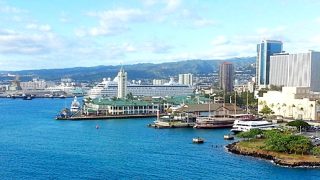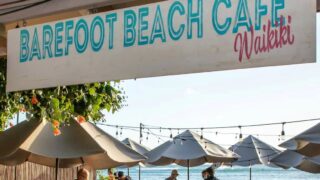The Hawaii Department of Health (DOH) shut down a Hilo restaurant on October 14 after inspectors found live cockroaches on food-contact surfaces and throughout the kitchen. But the closure wasn’t publicly announced until six days later, highlighting a larger problem with Hawaii’s food safety transparency.
The same agency responsible for inspecting and closing the White Guava Cafe, self-described as “a place where fond memories can be made,” also provides visitors and residents with a food inspection website so dysfunctional and poorly designed that it effectively hides the very information it claims to share.
What happened in Hilo.
Inspectors from the Food Safety Branch visited White Guava Cafe after an earlier conditional inspection. What they found was bad enough to warrant immediate closure. The official report listed live cockroaches on food-contact surfaces, numerous live and dead cockroaches throughout the kitchen and food storage areas, and unsafe food. Inspectors also noted that food-contact equipment and surfaces were not clean to sight or to touch, and poisonous or toxic materials had been stored where they could contaminate food, utensils, and single-use items.
A red placard was immediately issued, which ordered the restaurant to close until all violations were corrected and verified. White Guava Cafe is to remain shut until pest control confirms the roach infestation has been eliminated and the facility passes a follow-up inspection by DOH.
What stands out is that the inspection occurred on October 14, but the Department of Health didn’t post its press release until October 20, a long and unexplained delay. Other news organizations already mentioned the closure, but none examined the larger issue: whether the public could reasonably find this information on the state’s own food safety website.
The bigger problem.
Hawaii once had a reasonable and transparent food-safety system. A simple state-run website showed every restaurant’s inspection results, violation history, and color-coded placard grade. It was far easier to operate. Residents and visitors could more easily browse recent inspections before deciding where to eat.
Then, in 2024, that system disappeared without warning. The Department of Health announced it was changing vendors and then temporarily removed all public access. Beat of Hawaii reported at the time that the outage left diners in the dark, with no way to verify which restaurants had been cited or closed. Officials promised the new system would bring back public access soon.
That “new” system, found at https://inspections.myhealthdepartment.com/soh, is finally live. But what the state calls transparency is, from our analysis, anything but.
How the new site works.
In a word, it doesn’t. When you search for restaurants in Hilo, White Guava is not among the search results. You have to search by name to find it.
We also tried searching for a restaurant we like that has a green report and no issues found. It’s Kalaheo Cafe & Coffee Company. In this case, the opposite happened; if you search by name, no results are found. You have to search for the town name, Kalaheo, to see it listed with the other restaurants. We also noted that you have to leave the zip code field empty. If you add the zip code for Kalaheo Cafe, there are no results.
Another issue is that a date range must be specified when searching for restaurants. The site is not mobile-friendly either, and to make the calendar work efficiently, you have to be on your desktop. A map would also be helpful to locate restaurants.
The system’s logic is unpredictable and unreliable, even for those of us who have used it for years and know what we are searching for.
Even when a restaurant does appear, there are no color indicators in the search results to show whether it passed or failed. The details, if any, are buried deep within individual records. As we said, the website’s search feature behaves differently on mobile and desktop, and on smaller screens, it becomes nearly unusable, with the calendar and search tools hard to access, and layout elements not designed for mobile phones.
The broken red front door.
The problems start even before you get to the restaurant search. The Department of Health Food Safety Branch homepage looks more like a warning notice than a state resource. Nearly half of the page is covered in red text, bold headlines, and outdated internal notices. Instead of guiding residents to inspection data, the homepage reads like an administrative bulletin board gone wrong.


The section titled “News and Updates” lists a stream of unrelated updates, such as permit payment instructions and in-person class announcements, among other things. Nine months ago, on January 29, the Department of Health reported that the public could “browse past inspections.” Our testing in October, however, proves that the claim was misleading at best.
What’s online cannot be browsed in any reasonable sense, and the data it holds feels incomplete and obfuscated.
It’s not just poor design; it’s sadly symbolic. Hawaii’s most visible public health interface for visitors and residents presents as chaotic, dysfunctional, and uninviting. It sends the message that this information and its presentation are not well thought out or intended for the average resident or visitor to use.
Why this matters to everyone who eats here.
Hawaii once led the nation in visible food-safety enforcement. The color-coded placard system, introduced statewide in 2014, made it easy to see whether a restaurant passed inspection. That openness extended online, where anyone could browse recent closures and enforcement actions. For a state that depends on tourism and prides itself on aloha and trust, that kind of visibility was both symbolic and practical.
Now the DOH’s transparency, which once built confidence, has been replaced with opacity. The site exists again, but it’s nearly impossible to use. Unless a restaurant closure makes the news or is featured in a state press release, it isn’t clear how the public can reliably know it is happening.
A pattern of retreat.
This failure isn’t isolated. Hawaii’s public-facing systems have been steadily regressing. From tax portals to reservation platforms to permit renewals, government websites increasingly serve internal workflows rather than the public. Each “modernization” ends up harder to use, less informative, and more bureaucratic. The Department of Health’s site follows the same path.
Even other places that use the same My Health Department platform have made their inspection data far more functional than here in Hawaii. But Hawaii’s version seems to offer too little, with no easily visible grades, no recent-closure listings, and no easy way to find what’s safe or not before heading there.
Hawaii food-safety information is not optional.
It’s essential public health data. Visitors and residents deserve to easily confirm whether a restaurant has been cited for unsafe food practices, pest infestations, or contamination. The DOH continues inspections, which we believe are appropriate, and does issue red, yellow, and green placards. Without true online transparency, those enforcement actions might as well be invisible.
Visitors are left guessing, residents too lose confidence, and restaurants that do follow the rules are lumped together with those who don’t.
The fix is simple: willpower.
Hawaii already had the infrastructure, but it appears to lack the commitment to use it with integrity. The inspections are done, and the data exists. What’s missing is a tested, usable, and accurate public interface that lets residents and visitors see what’s happening without jumping through hoops, as we just did.
The White Guava Cafe closure proves the DOH is still doing its job and enforcing food safety rules in the field. That is reassuring. But when the public can’t easily find that information, the entire system suffers. Until Hawaii restores a fully functional, honest food-safety website, each of these “Closed” placards might as well not exist.
How confident are you in Hawaii’s food safety system if even serious restaurant closures can’t be easily found or verified online?
Get Breaking Hawaii Travel News







A critically important story. Food poisoning can kill you. And of all fifty states, here is the honest truth. Concerning food safety and cleanliness, I trust Hawaii restaurants the least. And by a significant margin. Please continue to report on this issue. Smart and informed people know how important this is.
And anyone with even a modicum of experience with CSS and HTML, or SQL, know this obfuscation is purposeful. Purposeful and intentional. A couple hours of informed redesign of a search prompt could fix it, easily. There literally are predefined global search elements and class calls that even a dumb developer could deploy in fifteen minutes to make the data searchable. It quite literally is and very simple call ids to the datasets.
The failure is purposeful and intentional.
Well, less confident at the moment and pop places that you would like to support. Otherwise, that’s why a condo is preferable so you can cook your own food. I would like to hear about grocery store inspections over there also. Maybe you could check that out. Mahalo
Where was this when I was teaching website usability? Talk about a textbook example of horrible user interface! Not to mention the fact that this terrible database dysfunction impacts real help of residents and tourists alike.
Someone needs to revisit Databases 101.
As restaurant out her friends bars have said, go into the bathroom of the restaurant the kitchen will be as clean as that bathroom and no more.
Sounds like the low price vendor over promised and under delivered. Not to worry though, they’ll fix all the bugs in the next update. Yeah, right.
Just another glorious example of Hawaii’s clown car incompetent state government at all levels. Voters wake up and free yourselves from this embarrassing train wreck, vote these idiots out!
It sounds like a case where the vendor salesperson did a great job and offered a price the state liked without anyone making a decision viewing the product.
Eating out can often be a roll of the dice. But when you’re spending $20-30 and up for a sandwich or salad, you’d like to know the place is at least clean and safe. We visit Hawaii twice a year. This year, we ate in more than usual to be safe. Next year, well, the govt there doesn’t seem to want us and doesn’t seem to care if restaurants make us sick, so we’ll head to California or Arizona for sunshine and relaxation. What I don’t understand is why the Hawaiian govt doesn’t fix the problem, at least for it’s own residents. Did the contract go to some politician’s cousin?
just the usual inefficient Hawaiian government outlook, lack of rules and avoiding of anything ethical or doing things the correct way. Again someone is getting paid (probably lots) for doing nothing and/or a very poor job.
Where the choice is conspiracy or incompetence, your usual best bet is incompetence. Sounds like a horrible IT vendor choice.
It seems like Hawaii’s government is becoming less transparent in many wa ways. Why did they stop using the color-coded placard grade. Hawaii citizens are not getting what they deserve. Need to vote out current officials.
The comment “oh you live in a third world country” seems to be really true in so many ways. Any attempt to have contact with a government agency seems to be filled with pitfalls.